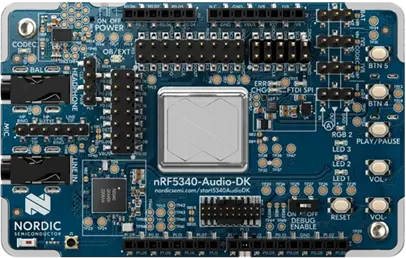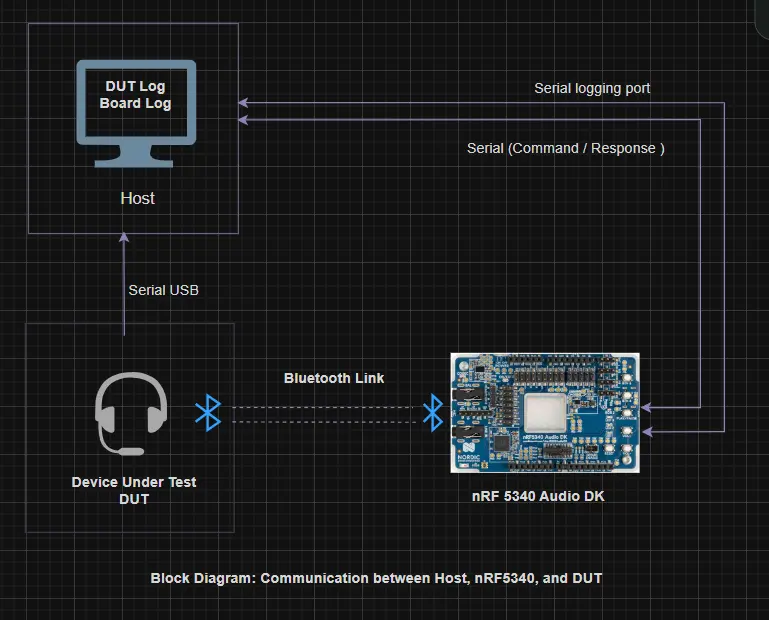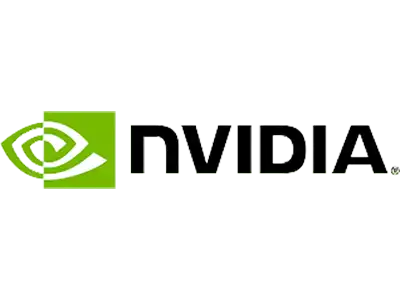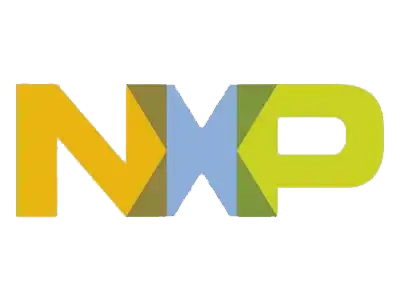Bluetooth LE Audio is revolutionizing the way we experience Bluetooth audio. As the latest Bluetooth standard, it offers fantastic new features, such as multi-stream audio and Auracast for audio broadcasting, in addition to improved audio quality and reduced power consumption. For many developers and startups, testing the new Bluetooth LE Audio features is expensive due to the unavailability of low-cost LE Audio-enabled phones.
Using the nRF5340 Audio DK and Python-driven automation as a new technology is both affordable and scalable. Whether you are a developer or a member of a larger engineering team, this method makes Bluetooth LE Audio testing easy and affordable.
What is LE Audio?
Bluetooth LE Audio is the new standard introduced by Bluetooth SIG, building on the latest Bluetooth LE (Low Energy) technology. This next-generation wireless audio technology is designed to enhance audio quality, reduce power consumption, and introduce innovative features for a wide range of devices. The development of Bluetooth has led to significant advancements, culminating in the creation of Bluetooth LE Audio, which brings improved power efficiency and new capabilities such as multi-device connectivity.
Some of the key features are listed below:
- Multi-Stream Audio: With this, a device can send several audio streams at once, keeping them perfectly in-sync. This solves the problem of syncing audio from one earbud to the other and is supported by Bluetooth LE Audio for devices like headsets and hearing aids.
- LC3 Codec: Bluetooth LE Audio uses the LC3 codec, a low complexity subband codec that provides high audio quality at a low data rate and low latency, resulting in power saving and efficient wireless transmission.
- Auracast broadcast: All nearby Bluetooth devices can listen to an audio stream, a feature supported by Bluetooth LE Audio for public and private listening scenarios.
- Support for Hearing Aids: The first official standard for Bluetooth hearing aid connectivity, supported by Bluetooth LE Audio and Bluetooth Low Energy Audio, enabling reliable, low-latency audio streaming for hearing aids and headsets.
LE Audio Use Cases
LE Audio is ushering in a new era of audio experiences by enabling a diverse range of innovative use cases that were previously impossible or impractical with older Bluetooth technologies. One of the most transformative features is broadcast audio, which allows a single audio source to stream audio to an unlimited number of nearby devices. For example, in public venues like airports, gyms, or museums, LE Audio can be used to broadcast TV or announcement audio directly to users’ headphones or truly wireless earbuds, creating a personalized and immersive listening experience without background noise.
Another significant use case is in the development of advanced hearing aids. LE Audio’s support for direct Bluetooth connectivity means that hearing aids can now connect seamlessly to smartphones, TVs, and other Bluetooth-enabled devices, providing users with greater accessibility and convenience. The low complexity communications codec (LC3) at the heart of LE Audio ensures that audio streaming remains high quality while minimizing power consumption, which is crucial for battery-powered devices like hearing aids and wireless earbuds.
Additionally, LE Audio’s low power requirements and efficient audio transmission make it ideal for the next generation of truly wireless earbuds and headphones. Users benefit from longer battery life, improved audio quality, and the ability to connect to multiple devices or participate in shared audio experiences. These advancements are driving the development of new audio products and applications, expanding the possibilities for how users interact with audio in their daily lives.
Comparison to Classic Audio
LE Audio represents a significant leap forward compared to Classic Audio, offering a host of improvements that enhance both performance and user experience. While Classic Audio relies on the Bluetooth Classic radio and the SBC codec, which limits audio quality and increases power consumption, LE Audio operates on the more efficient Bluetooth Low Energy (BLE) radio and utilizes the advanced LC3 codec. This combination delivers superior audio quality, even at lower data rates, and extends battery life for devices such as headphones, earbuds, and hearing aids.
One of the most notable differences is LE Audio’s support for multiple audio streams. Unlike Classic Audio, which is restricted to a single audio stream per connection, LE Audio enables multiple, synchronized audio streams from a single source device. This capability opens the door to new audio applications, such as seamless stereo sound in truly wireless earbuds and more interactive audio experiences for users.
Furthermore, LE Audio’s lower power consumption and improved connection reliability make it ideal for modern audio applications where efficiency and performance are paramount. By enabling new use cases and supporting a broader range of devices, LE Audio is setting a new standard for Bluetooth audio, moving beyond the limitations of Classic Audio and paving the way for the next generation of wireless sound.
Why LE Audio Matters?
LE Audio is not just about clearer sound or longer battery life (although those are great). It unlocks new possibilities:
- Clearer Sound with Less Data Usage.
- Longer Battery Life for Wireless Devices.
- Multiple Audio Streams from a Single Source.
- Public Audio Broadcasts Through Auracast.
- Better Accessibility for Hearing Aid Users.
With LE Audio, users can add broadcast audio functionality to their devices, enabling streaming to multiple listeners at once. Broadcast audio opens significant new possibilities for public and shared audio environments, such as airports, gyms, and conference centers. These advancements create significant new opportunities for both consumers and commercial applications, allowing for innovative audio experiences.
Examples of new use cases enabled by LE Audio include personal audio sharing—where you can share your music with friends nearby—and location-based audio sharing, such as receiving real-time audio information in museums or transit stations.
The Challenge: Expensive, Complex Testing Environments
To test LE audio functionality, such as pairing, connection, or connection stability, and synchronized multi-stream audio, broadcast by traditional methods, you need to develop a software application on the Android/iOS phones or require Appium to run different tasks on the phone. Currently, there are not many LE-Audio enabled phones available in the market that support all LE-Audio features.
In a typical LE Audio test environment, the audio source device is responsible for transmitting audio streams, while audio sink devices receive and play these streams. This setup allows for comprehensive testing of broadcast audio, multi-stream audio, and personal audio sharing scenarios.
The Solution: Affordable Test Automation with nRF5340 Audio DK
The solution below provides an affordable, scalable LE audio test framework with:
- The nRF5340 audio development kit.
- Python scripts for device control and log management.
- pytest for automated, repeatable test execution.
- Custom logging for real-time debugging and post-execution analysis.
This framework enables developers to evaluate both sink devices and source devices in various scenarios, giving complete control over their test environment while lowering hardware costs.
Why the nRF5340 Audio DK?
Nordic Semiconductor’s nRF5340 Audio DK was built specifically for LE Audio development. This dual-core Bluetooth 5.2 development kit has the following features:
- Support for native LC3 codecs.
- Multi-role capabilities: Headset, gateway, broadcast, or unicast.
- On-board SEGGER J-Link debugger.
- Dual-core ARM Cortex-M33 SoC (128 MHz + 64 MHz).
It is targeted explicitly for LE Audio use cases, including public audio broadcasts and multi-stream testing, while generic BLE development boards are not. It is unbelievably cheap compared to “LE-Audio” enabled phones currently available in the market.
It is unbelievably cheap compared to “LE-Audio” enabled phones currently available in the market.
For additional support and documentation, developers can visit the product page, where they will also find a library of resources for the nRF5340 Audio DK.

Python CLI for LE Audio Control
To make the process of testing LE-Audio easier, this solution provides a simple, lightweight interactive Python-based Command Line Interface (CLI) that interfaces directly with the nRF5340 Audio DK using serial communication. There is no longer a need to physically press buttons to change states or reset the hardware repeatedly between tests, all of that can be done from the terminal.
How It Works?
This tool is designed with an interactive menu system:
- When launched, the Python script automatically detects and connects to the development kit’s serial port.
- Once connected, a menu appears listing all available actions (like connect, scan, play, disconnect, and reset).
- You just enter the number of the desired operation. The corresponding command is sent over the serial interface, and the DK’s response is displayed instantly.
- It supports essential LE Audio actions, such as:
- Device scanning.
- Connecting/disconnecting/unpair.
- Audio playback controls.
- Triggering a software reset on the DK.
This CLI is ideal for development, debugging, and automated validation—all without touching the board. This tool’s API’s can also be called directly from the Python test script.
Automation setup: Host ↔ nRF5340 ↔ DUT

In the LE Audio test framework, communication between components follows a clear and efficient path that enables full control and monitoring of Bluetooth interactions.
Here is how it works:
- A Python script running on the host PC acts as the main controller. It sends commands like scan, connect, play, or disconnect via a serial connection to the nRF5340 Audio DK.
- The nRF5340 working as a Bluetooth Central, takes those commands and interacts with the Device Under Test (DUT) over Bluetooth. It performs the necessary actions, such as discovering nearby devices, initiating connections, and managing audio playback.
- The DUT responds through the Bluetooth link. The nRF5340 captures the responses of corresponding operations and sends updates back to the serial interface.
- At the same time, the nRF5340 continuously captures streams logs—including status events, debug messages, and runtime data—via a separate serial port dedicated to logging. This is useful for real-time debugging and monitoring.
Automating LE Audio Tests with pytest:
- Manual testing is useful in the initial stages of development, but it does not scale well particularly when the test needs to be executed multiple times during the product development cycle. That is why we have incorporated pytest, a Python test framework, to do automated LE Audio validation end-to-end.
Why It Works So Well
- Fully Reproducible: Tests execute the same way every time, removing variations.
- Catches Regressions Early: Great for continuous testing as firmware evolves.
- Saves Time: Eliminates the need to repeat manual steps.
- Readable Logs: Logs all test outcomes, making failure analysis quick and easy.
Real-Time Logging System
To help developers troubleshoot issues quickly, we have built a two-tier logging system right into the framework:
- Full Session Log: Records all test actions, including timestamps and replies.
- Quick View Log: Shows only the latest command/output for quick debugging.
Both are accessible directly from the Python CLI interface—no need to use any external tools or hardware terminals.
Affordable LE Audio Testing: Dev Kits vs. Smartphones
Flagship smartphones supporting LE Audio, such as Google Pixel 9 or Samsung Galaxy S24 Ultra, cost US$ 999-1,199 — but provide limited access to low-level logs, protocol debugging, and lack native automation control.
Compared to that, the nRF5340 Audio DK provides the features listed below at just $150–$200 USD:
- Detailed low-level logs.
- Multi-role LE Audio operation.
- Automated, scriptable testing.
Future Improvements:
- Automated audio quality analysis.
- Auracast broadcast scenario testing.
- Integration with CI/CD pipelines.
- Python GUI for simplified operation
Conclusion
This project shows how the integration of available hardware such as the nRF5340 Audio DK with open-source software such as Python and pytest can minimize the complexity of LE Audio testing—making it cost-effective, reproducible, and scalable.
The potential for future growth—including CI/CD integration, GUI dashboards, and Auracast testing—makes this a versatile and future-proof solution for Bluetooth audio validation.













